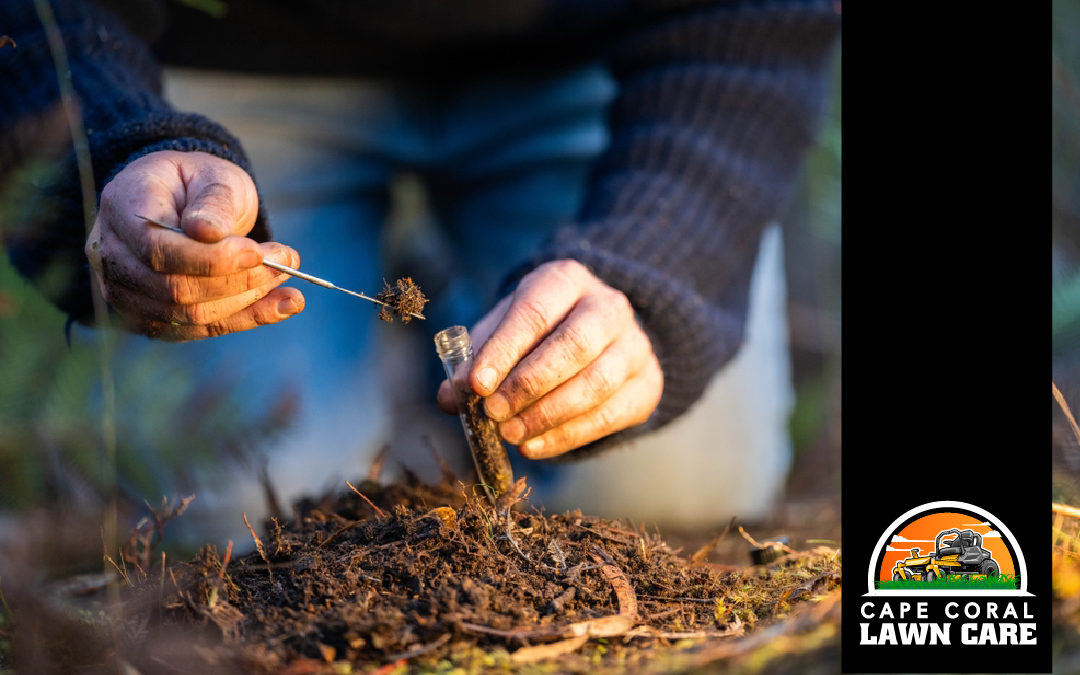As a seasoned lawn maintenance technician here in the sunny, oftentimes humid southwest Florida, I can’t stress enough the significance of knowing what’s beneath your feet before tackling that lush, green lawn of yours. So let’s dig deep—pun intended.
Why Soil Testing is Crucial
Knowledge is power. And in lawn care, it all starts with your soil. Here’s why testing your soil beats simply winging it:

- Nutrient Needs: Different grasses require different nutrients. Find out your soil’s pH and nutrient levels with a simple test. It’s easy! This ensures you’re not just throwing fertilizers at the lawn like confetti at New Year’s Eve.
- Avoiding Over-Fertilization: No one wants to be that neighbor with the burnt, brown patches on their lawn because of over-fertilizing. Knowing your soil’s needs helps you use the right stuff, in the right amounts. Time and money are saved!
- Improving Soil Health: There’s a direct connection: fertile soil equals a thriving, green lawn. Sometimes soil needs a helping hand. Adding organic matter might make your garden thrive, but a soil test will tell you for sure. Think of it like giving your plants a multivitamin!
- Water Efficiency: Florida’s heat can be relentless, and the last thing you want is to waste water on a lawn that doesn’t need it. The type of soil you have directly impacts your lawn’s water requirements. Pay attention to your soil; it will tell you exactly how much water to give your grass and how frequently. You’ll have a lawn that’s not only healthy, but also thriving; a testament to your green thumb and hard work. Picture it: thick, emerald blades of grass, resilient against the elements.
The Soil Testing Process: What to Expect
So, how do you test your soil? Here’s a quick rundown of the steps involved:
- Collecting Samples: Use a clean trowel or soil probe to sample different areas of your lawn. Aim for a depth of about 4-6 inches. Accurate results come from combining samples taken from several locations to create a representative average sample.
- Send It Off: Many local extensions or commercial labs can analyze your soil. Make sure to follow their guidelines when shipping off your samples.
- Understanding Results: Once you receive your results (usually taking about a week), look at pH levels and nutrient availability. Each will be ranked, enabling you to create a tailored care plan.
Common Soil Trends in Southwest Florida
Let’s talk about the unique challenges of our local soil in southwest Florida. Typically, our sandy soils can be trickier than they seem:
- Low Nutrient Retention: Most sandy soils here drain quickly, which often leads to nutrient loss. We need to test things more often and make changes as needed.
- pH Levels: Florida soils can be acidic, which isn’t ideal for all grass types. To get the best growth, use your soil test results to adjust the pH level. For flourishing plants, pay attention to the soil’s acidity; the pH level significantly impacts their ability to absorb nutrients.
- The environment: It’s all about impact. To save plants and animals, first understand their soil. Clean water depends on it too. This protects the whole ecosystem. Hey everyone, let’s protect our beautiful beaches!
Best Lawn Practices Post-Testing
Once you’ve done your due diligence and tested your soil, you can take strategic steps to improve your lawn care regimen:
- Aeration: If compacted soil is identified, aeration can relieve that pressure and promote deeper root growth. It’s like a day of pampering for your grass.
- Custom Fertilization: Armed with your soil test results, choose the right fertilizers that provide exactly what your lawn craves.
- Smart Watering Practices: Based on your test results, create a watering schedule. Avoid water waste, but still get those deep roots. Success depends on proportion. Too much of one thing and not enough of another creates imbalance, like a wobbly three-legged stool. Get the amounts just right, and everything clicks into place. Imagine this scenario… a thirsty plant with shallow roots will drink up all the water quickly, while a plant with deep roots can access water stored lower down.

Conclusion
Fixing lawn problems without knowing the cause is like putting a bandage on a broken leg—it doesn’t really solve anything. Testing your soil first means a thriving garden, not just chemical-filled dirt. So, embrace the knowledge, skip the guesswork, and let your lawn thrive like our palm trees in the Florida sunshine!
So, when it comes to lawn maintenance, always remember: test, don’t guess. Your soil will thank you—trust me!

